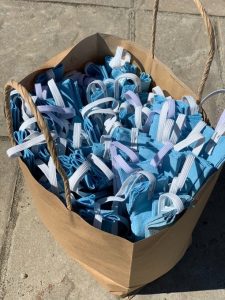NOSM medical students are making homemade masks, in an effort to save N95 and surgical masks for front-line health-care workers who need them most.
 Photos were supplied by medical students Doniya Quenneville and Jenny Thomas.
Photos were supplied by medical students Doniya Quenneville and Jenny Thomas.
NOSM medical students are making homemade masks, in an effort to save N95 and surgical masks for front-line health-care workers who need them most.
 Photos were supplied by medical students Doniya Quenneville and Jenny Thomas.
Photos were supplied by medical students Doniya Quenneville and Jenny Thomas.
Over 100 student volunteers from NOSM, Lakehead University and Laurentian University are working together to collect and redistribute existing Personal Protective Equipment (PPE) to those who need it most. In addition, they’re producing and distributing face shields via 3D printing and laser cutting.
The volunteers are in over 30 communities across the North, and have developed this effort in conjunction with the Ontario Medical Association and the Ontario Medical Student Association.
Read more about how NOSM and its partners are working together to alleviate the shortage of PPE.
Many NOSM learners are helping parents, volunteering, and acting as caregivers to the elderly, immunocompromised.
Justina Marianayagam, second-year medical student, thanked NOSM for creating an emergency policy, allowing students to take “Personal Days” from their academic duties to prioritize these commitments. As a result, Justina is able to take care of her nephew.